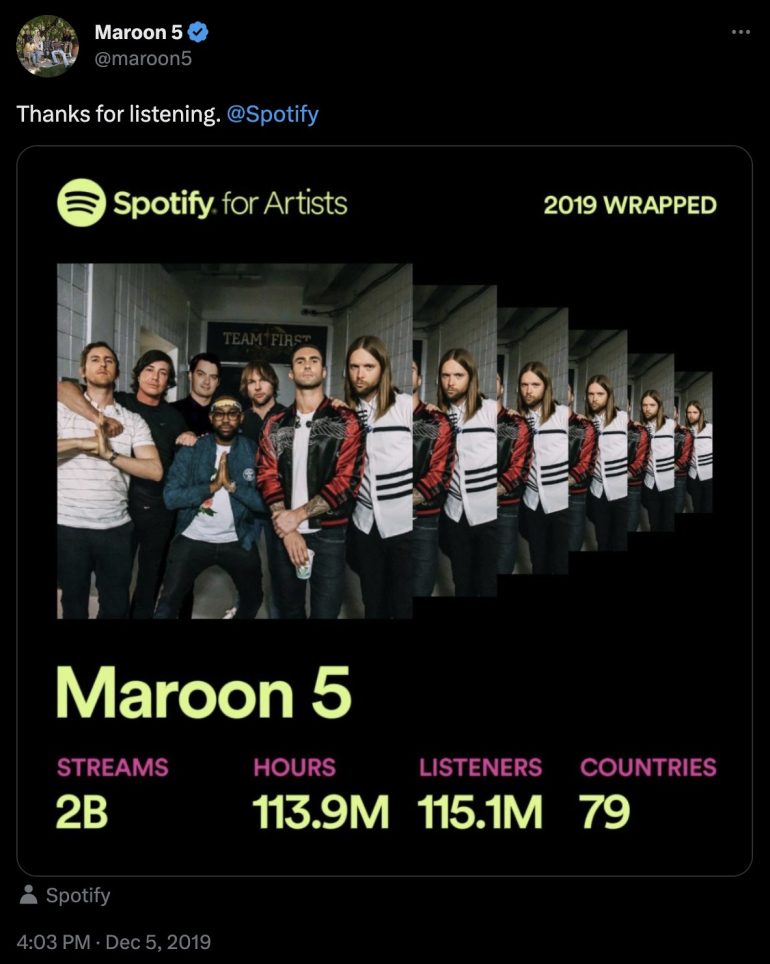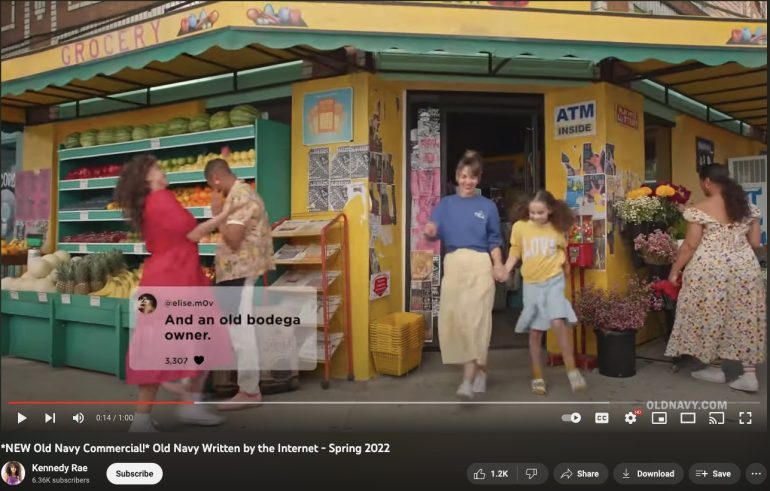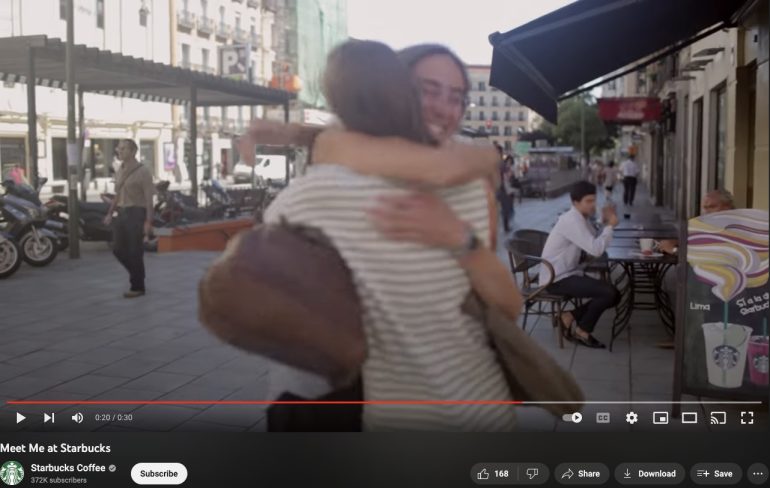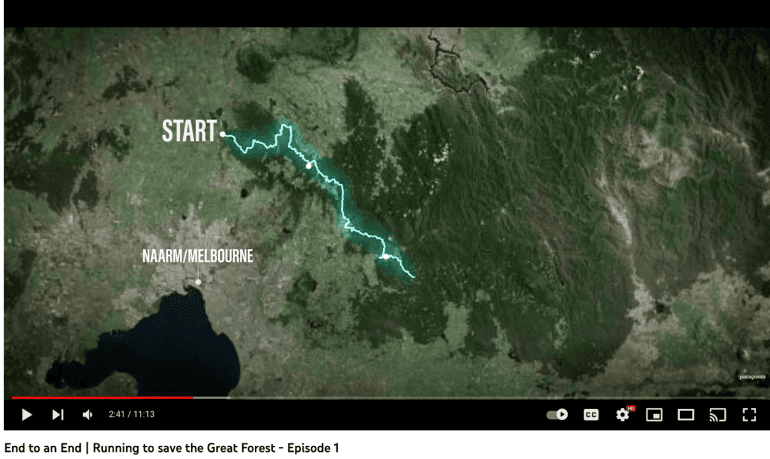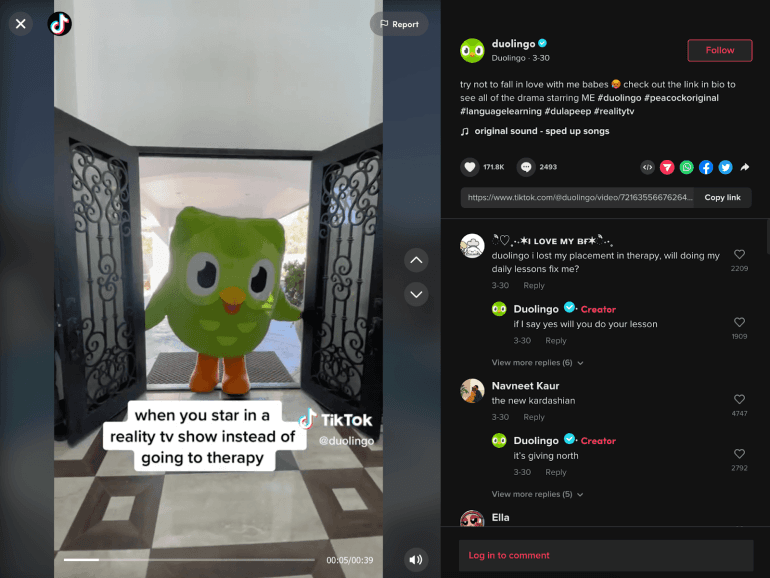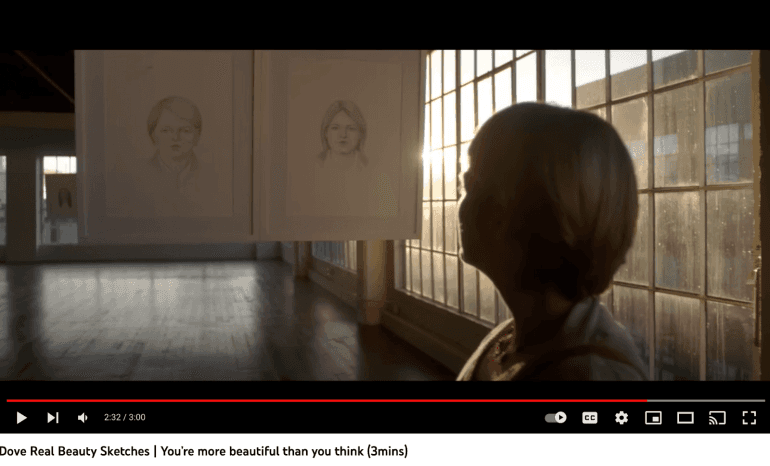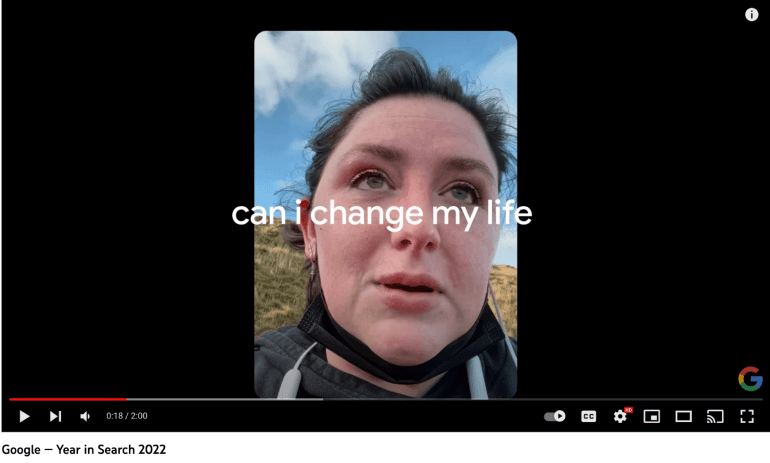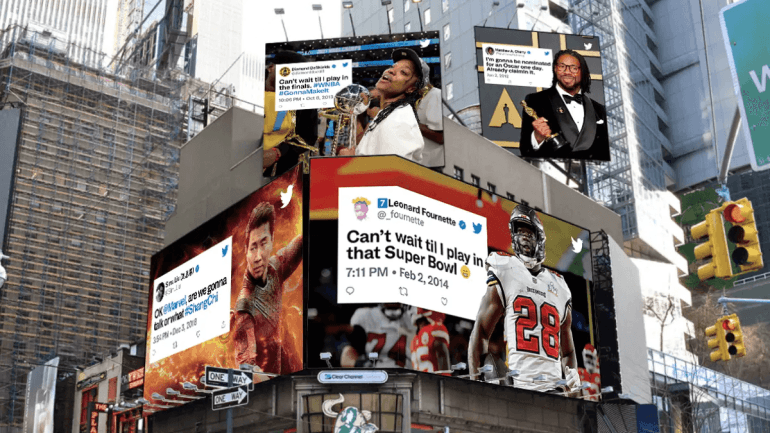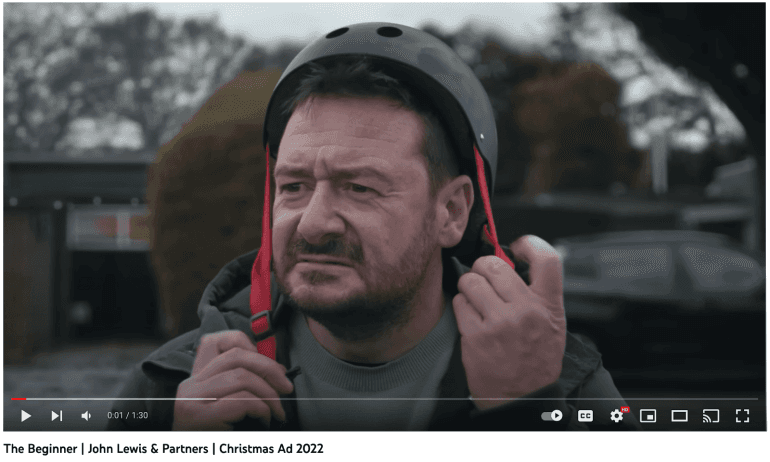When brainstorming about how to market your brand, you want to stand out from the crowd. A great way to do this is by understanding the examples of top companies.
Here, we’ve compiled a list of 15 real-world marketing examples from brands of all sizes and industries. Besides showing why each example is excellent, you’ll uncover learnings to help you reverse-engineer and apply them to your brand.
Let’s get going.
1. Coca-Cola: Take Advantage Of Seasonality
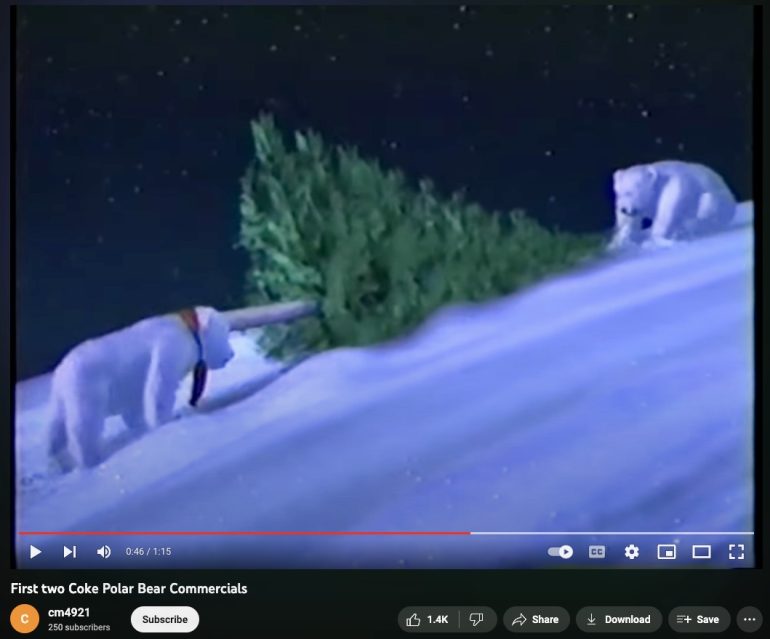
First two Coke Polar Bear Commercials
Why It’s A Good Example
- Coca-Cola has permanently integrated itself into the holiday season with this line of commercials. The image of the Coca-Cola polar bear has become so iconic that most people know it will be a Coca-Cola advertisement as soon as they see a polar bear. The holiday season represents joy and family coming together, and Coca-Cola has found a way to intertwine itself with these feelings and traditions.
- The polar bears in this commercial are cute, playful, and innocent. Studies show that we are hardwired to enjoy cute things. Cute things provide our brains with rewarding neurotransmitters and cause us to pay attention and care more.
- The style of this advertisement also helps it to stand out. The Coca-Cola team animated the commercial using no dialogue. The animation allows for a pattern interrupt that grabs the consumer’s attention and creates a memorable experience.
What You Can Learn From This Example
- Seasonality is important. Coca-Cola chooses to run these advertisements during the holiday season to attach the idea of the brand to the joyful memories of the holidays. They further associate themselves with that time of year and family traditions by airing these only during the holiday season.
- By continuously reusing the polar bear concept, Coca-Cola has developed a character that can be immediately associated with its brand. This character can also be used in merchandise and products, opening another sales market for Coca-Cola.
- Many brands use animal characters to promote their products consistently. Whether it be Tony The Tiger, the Aflac duck, or the Geico gecko, humans experience positive feelings from animals, making it an ideal approach for emotional marketing.
2. Dollar Shave Club: Never Be Lost In A Sea Of Competition
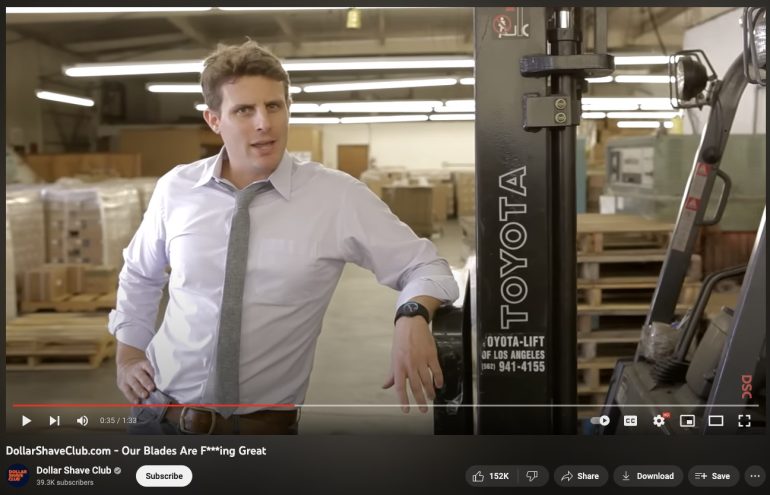
Why It’s A Good Example
- Ever been confused about the concept of an ad? Not with Dollar Shave Club! They let you know what their brand is about right away. Their promise to deliver high-quality razors right to your door for a dollar a month is a unique tagline.
- Dollar Shave Club represents itself as a “club” that is off the cuff and different from typical razor companies. They have identified a separate target audience that does not associate themselves with the sophisticated gentleman culture most razor advertisements push. Instead, this audience relates to a company that’s informal and good-humored.
- The advertisement is funny and constantly keeps the audience guessing. Whether it be the man with shaving cream on his head or the bear mascot, the ad keeps you looking forward to the next scene. Creating humorous content that is engaging and shareable is the perfect recipe for making viral videos. Dollar Shave Club has successfully done this and has over 27 million YouTube views on this video.
What You Can Learn From This Example
- Dollar Shave Club makes sure you know what they are about immediately. Their tagline is catchy, and they market to a group of consumers who value affordability, humor, and convenience.
- Know your target audience. This advertisement selects an audience that enjoys a good laugh and does not get offended easily. Swearing in commercials is a risk, as it may be off-putting, but in this case, dropping the F-bomb grabs the attention of the intended viewers and makes it memorable.
- The humorous twists and turns leave the audience with no idea what to expect and eager to see what’s next. It’s not so random that it causes consumers to lose track of the message. The camera focuses on the main character as he ventures through the warehouse and uses great transitions to keep the message on track.
3. Nike: Helping Make Dreams A Reality
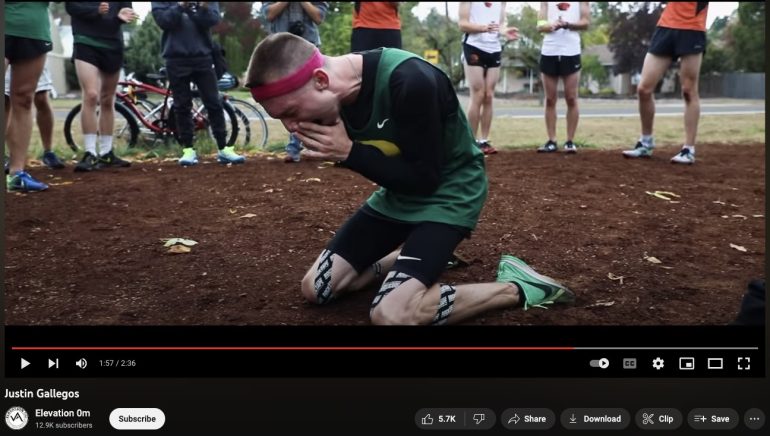
Why It’s a Good Example
- This advertisement from Nike does a fantastic job of telling a story- one of the most effective marketing methods. In a world where brands bombard consumers with ads, explaining only product features won’t cut it. Brands need to connect with consumers’ emotions and create an identity of what they are about.
- The heartwarming narrative of how Nike helped a real person achieve an extraordinary goal will stick with almost any audience. Stories that conjure up emotions are far more likely to be remembered than facts. Customers know Nike for creating inspiring advertisements, and this one is no exception. The piece’s tone connects to the established Nike brand of overcoming adversity to achieve incredible things.
- This advertisement also has limited dialogue and instead uses music to evoke emotion. Music has powerful effects on the brain. It can get us fired up for the gym, anxious during a scary movie, or bring about tears after a breakup. Selecting the right variety of music for an advertisement can significantly intensify consumers’ emotions.
What You Can Learn From This Example
- Nike’s storytelling skills are a lesson that any marketer can use. The advertisement’s tone, including music and the documentary film style, creates a memorable and touching narrative. The aspirational runner in the commercial is also someone with a unique story and a person we want to cheer on.
- Not only is this story touching, but it’s also inspiring. The runner in this story has overcome significant obstacles in his life, and Nike empowered him to do so. This gives consumers a sense that the brand will help them achieve goals beyond their wildest dreams.
- The music choices for this commercial help reinforce the inspiring story that Nike is trying to tell. The video, paired with music that evokes an emotional reaction, engages viewers with the narrative and makes it memorable.
4. Busch Light: Sponsorships And Influencers
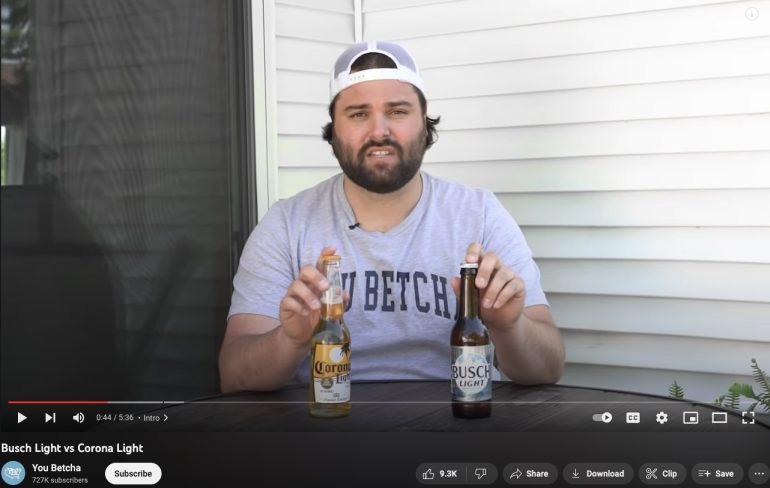
Why It’s A Good Example
- Busch Light used a fan with a large following and turned him into an advocate for their brand. You Betcha represent a crowd of simple, blue-collared Midwesterners, the ideal target audience for Busch beer. Followers of You Betcha look up to the main character and value his opinion, which creates trust with the brand.
- Busch has become so intertwined with You Betcha that everything the viral media company does is an advertisement for Busch. Nearly every video produced illustrates this man’s loyalty to Busch Light. The connection is so strong that even videos that do not directly advertise Busch still trigger the thought of the beer to devoted followers of the series.
- This is another excellent example of using tasteful humor to make shareable content. Those that relate to the brand’s message can’t wait to repost to their page and get a rise out of their own followers. It feels rewarding when our posts get engagement and provide joy to our friends, and Busch certainly doesn’t mind the spreading of their advertisement!
What You Can Learn From This Example
- Develop partnerships with fans. If you know someone out there who is a user with considerable influence, offer them a sponsorship to become a promoter of your brand. They will become even more loyal to you as they are excited about the free products and benefits, and the business reaps the rewards of instantly getting in front of a large target audience.
- This advertisement didn’t have expensive production or advanced video editing skills. It’s pretty amateur and straightforward in this sense. The ad’s simplicity appears more authentic and relatable to this target audience. Quality is essential, but the quantity of content is equally paramount to spreading your message to more consumers.
- When there are dozens of other competitors on the shelves, as with light beer, think of the message you can deliver to consumers to let them know what your product is all about. The goal is not to relate to everybody. Trying to do so will usually hinder success. Find the concept that works for your target audience and hammer that idea home.
5. Slack: Product Led Growth
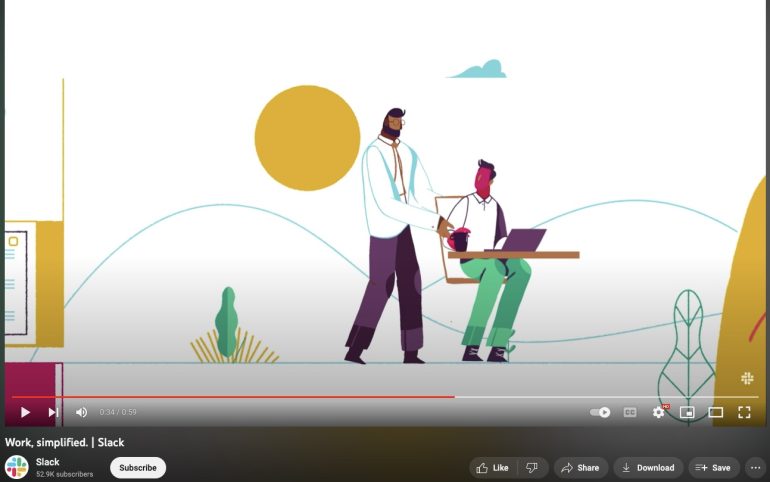
Work, simplified.| Slack
Why It’s A Good Example
- This advertisement identifies the correct audience by targeting software users instead of decision-makers. Heads of companies may not see the need for this product as much as their employees who experience the problems Slack solves.
- It describes that the product will allow you to work and communicate faster, making it the perfect tool for someone looking to make their busy workday more efficient. The commercial explains how you can work inside and outside of your company on their platform and make your team more productive and connected.
- The commercial’s style is bright and quick, reinforcing the positive way Slack will make you and your employees more efficient. The animation and drawing style are eye-catching and help attract viewers and entice them to learn more about Slack.
What You Can Learn From This Example
- By highlighting the daily experiences of the customer base that your product or service will most affect, you can make sure to reach your target audience. By advertising more to the general user than a decision-maker, Slack can speak to an audience that could benefit greatly from their service.
- This commercial uses outcome-based selling, focusing more on discussing the customer’s priorities than the product’s features. Slack doesn’t go into detail about how to use their product or why a specific characteristic makes it the best. It simply sells the result of communicating more efficiently, ultimately, what their customer needs daily.
- This ad’s fast-paced and bright style helps remind the consumer of the speed and convenience of Slack. The bright colors and poppy animation are eye-catching and fun and reflect Slack’s overall efficiency, speed, and informal communication style.
6. Old Spice: Data Is Vital For Ads To Convert
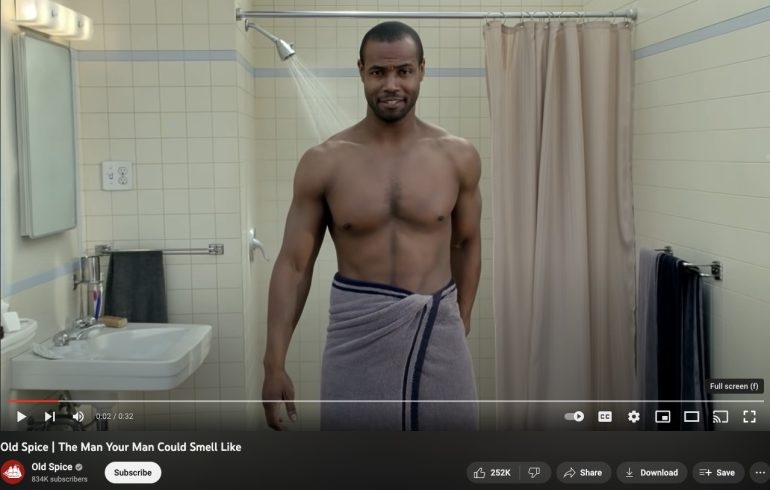
Old Spice | The Man Your Man Could Smell Like
Why It’s A Good Example
- This advertisement does a great job of using a celebrity to market Old Spice. It stars Isaiah Mustafa, a former NFL player, to illustrate the “perfect manly attributes” a woman may desire. As a brand, identifying the needs or desires of your audience can help you unlock angles for advertising your product.
- The goal of this ad was to start a conversation between men and women about body wash. At the time, there were many “lady-scented” body washes, but similar products for males lacked credibility. This informed the positioning of Old Spice as the only choice for females who want their male partners to “smell like a man.”
- The protagonist’s charismatic appeal, youthfulness, and mild humor could make the male viewers fantasize about their smell after using Old Spice. Plus, it encourages women to think about how their man will smell after using Old Spice.
What You Can Learn From This Example
- The Old Spice classic proves that your product’s users may not be your product’s buyers. While men used the Old Spice body wash, studies confirm women purchased 60% of men’s body washes. Therefore, this ad targeted females because they made the most buying decisions. So, dig deep for data and use these insights to target the real buyers of your product.
- Choose characters that your audience relates to. This ad starring Isaiah Mustafa, a former NFL player, was deliberate. Here’s how: The Wieden & Kennedy agency launched the Old Spice ad during a Super Bowl showdown, meaning, besides perfect timing, the ad had a relatable character for Super Bowl enthusiasts.
- Set the scene for your ad. Notice that this ad flows with Isaiah in the shower, to a boat, to something relatable (two tickets), and onto a horse. These are excellent transitions, which help to pass the message without losing the audience. And let’s not forget the memorable one-liner — “I’m on a horse.” Try associating your brand with a catchy phrase.
- Think about more than the TV audience. At over 60 million YouTube views, the Old Spice ad proves you can get significant results from an online audience. You don’t have to spend millions of dollars on a Super Bowl ad in under one minute. Do it for free online.
7. Twix: Compete Against Your Product
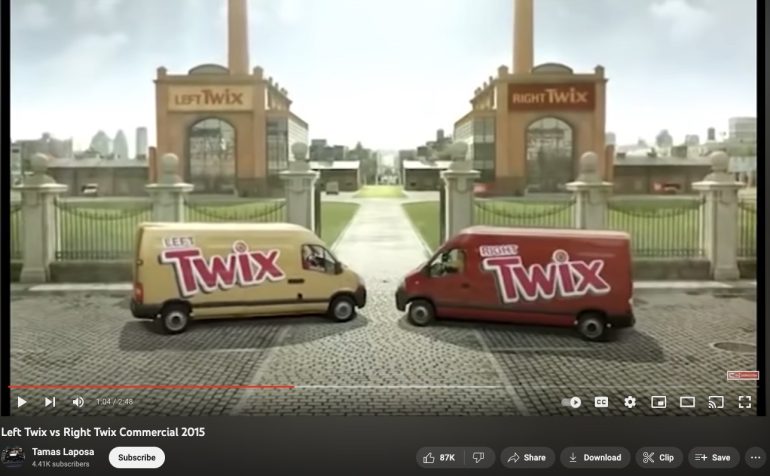
Why It’s A Good Example
- As a common technique, many brands invent a fictitious competitor when they want to show the excellent features of their products. This ad doesn’t do that. Instead, Mars Inc. made “Left and Right Twix,” and compared both chocolate bars by telling a story about their history. This idea is brilliant because it doesn’t matter what bar customers choose; the company wins as they make them both.
- This commercial generated a real brand buzz for Twix. Besides having over 3 million YouTube views, many tweets with a minimum of 100 retweets mention “Left Twix.” The same applies to “Right Twix.” These outcomes occur because of the silly, humorous, and dramatic feud between the two sides of Twix, resulting in a split society of “Right vs. Left Twix” fans.
What You Can Learn From This Example
- Spark a conversation. If your audience gets a talking point from your ad, they’ll use it for many years. This phenomenon has happened with Twix. To date, fans on either side of Twix ask people to pick a side. You are either Left Twix or Right Twix.
- Find a unique way to engage with your audience. Notice the humorous ad set up with both brothers having a feud, refusing to give up control, building two factories directly across from each other, and producing similar candy bars with the same ingredients, but having different packaging. When adopting this ad strategy, you’ll want your audience to have something they relate to. This could be taste, packaging, size, etc.
8. Red Bull Stratos: Big Results Require Big Investment
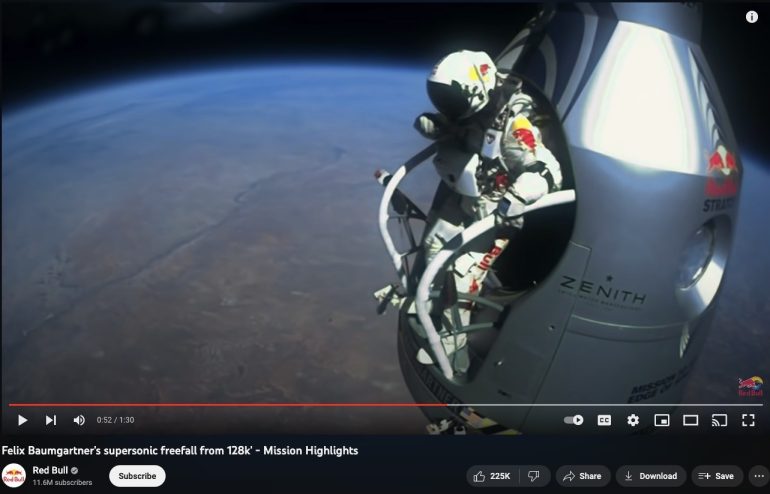
Felix Baumgartner’s supersonic freefall
Why It’s A Good Example
- The Red Bull Stratos is a fine example of how thorough planning can create buzz. This “project turned live event” became a viral success after approximately five years of training and preparation by putting together the required people, processes, and technology.
- This ad gave meaning to Red Bull’s famous and memorable advertising slogan: “Red Bull gives you wings.” Before the ad, this slogan never meant much. But after sponsoring the space jump of Felix Baumgartner, this slogan made sense. Here’s why: the maximum height of birds is a meager 11,300 meters, whereas Red Bull armed Felix with the wings to reach an amazing 38,969.4 meters.
What You Can Learn From This Example
- Build anticipation. Red Bull built lots of anticipation for the jump for an entire year. They created a dedicated Facebook page with over 774,000 followers. They also packed this page with quality content, refrained from giving everything about the jump away, and took decisive steps to keep the audience intrigued. Consider taking a similar approach if your brand is investing in an enormous project or product launch.
- Create social media engagement. Throughout the event, the Red Bull team engaged their audience by asking several questions on their Facebook and Twitter pages. Doing this allowed them to foster a strong sense of community around the project. Besides using text posts to engage your audience, be sure to use text and even video polls to add personality to your brand.
- Put in the work. Instead of rushing to get your ad out the door and make quick sales, invest resources to make the project interesting enough to start conversations. This way, long after you’ve hit the brakes on the project, people will continue talking, you’ll keep gaining mindshare, and you’ll keep selling.
9. DoorDash: Be Sensitive To Your Audience’s Feelings
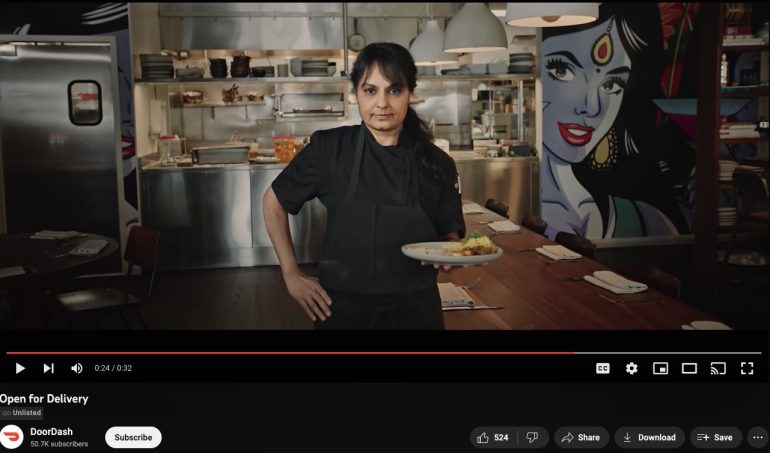
Why It’s A Good Example
- Keep your advertisements in line with current events. DoorDash rolled out this ad in the heat of the COVID-19 pandemic. Businesses of all sizes were taking a hit, making this period financially and emotionally painful. Tapping into these pain points with a brilliant ad increased DoorDash’s brand awareness and gave them lots of goodwill.
- It supports local businesses. In the US alone, over 400,000 small businesses closed shop within 3 months of the pandemic. Stepping up to show support for these businesses was a smart play that shows DoorDash cares.
- The company used top independent chefs and operators to convey its message. The use of real people gives it a personal touch. A heartwarming part of this ad was this statement: “They’re still there for you, now you can be there for them. While the doors may be closed, the kitchens are open for delivery.” This sentiment fosters a feeling of love and care, which was very valuable during the pandemic.
What You Can Learn From This Example
- Support causes that your target market cares about. During the pandemic, restaurant business owners had reduced consumer traffic because of lockdowns, social distancing, and operational restrictions. This led to some permanent closures and lost jobs and livelihoods. These were worrying. But by showing support, DoorDash proved they were in-tuned with their audience.
- Use multi-channel campaigns. DoorDash didn’t limit this campaign to just online. They got TV spots in the U.S. and Canada, used paid ads and organic social media to boost their reach, and even launched a new website solely for this campaign. If you have the resources, extend your reach like DoorDash, especially after testing and seeing the ad gain traction.
- Always appeal to emotions. DoorDash’s 30-second commercial helped viewers recollect how restaurants were during normal times. The commercial starts with several empty dining rooms, highlights some reasons for using a restaurant, shows a chef laboring alone in a kitchen, and concludes with shots of packaged food for delivery pickup.
10. Southwest Airlines: Stories of Real People
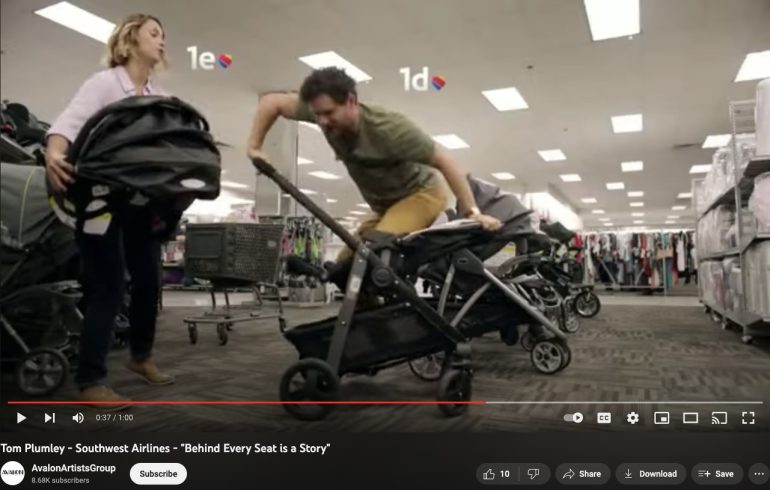
Southwest Airlines- “Behind Every Seat is a Story”
Why It’s A Good Example
- It connects with people on a personal level. With this campaign, Southwest Airlines used authentic customer stories to remind airline passengers that they are the reason for the company’s existence.
- The ad uses superb storytelling to show why customers fly. After collecting 175 customer stories, Southwest Airlines used a few of them for the ad. There’s the story of an inspirational coach flying for his team’s game, a grandmother fulfilling her goal of visiting Belize, parents preparing to adopt a child, an MC going for a show, and more.
- Southwest Airlines showed attention to customer needs. Air passengers didn’t like charges associated with changing flights or checking in their bags. Knowing this insight, the ad team brilliantly used the ‘transfarency’ tagline to show customers they offer transparent and low fares.
What You Can Learn From This Example
- Find opportunities to humanize the brand. As Ryan Green, Southwest’s Vice President and Chief Marketing Officer said, “This campaign is an opportunity for us to remind the world that there is a personal reason someone chose to fly Southwest Airlines.”
- Create memorable taglines around customer pain points. This ad’s ‘transfarency’ message hit home, giving passengers something to remember about Southwest Airlines.
11. GEICO: Use Catchy Jingles
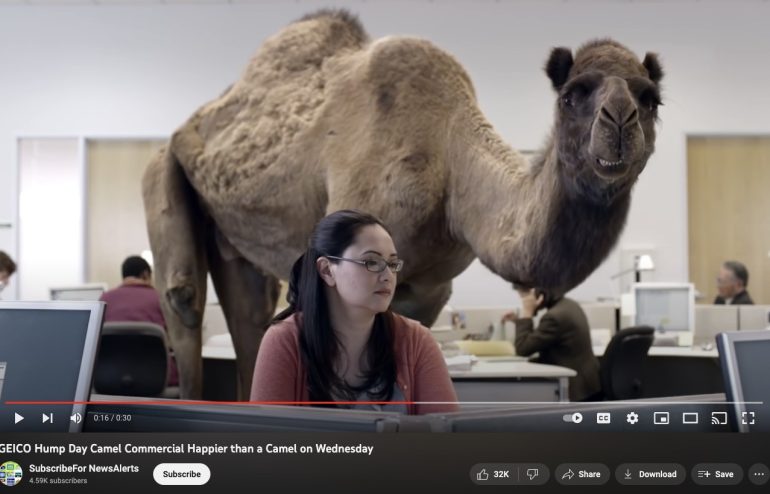
Why It’s A Good Example
- GEICO used a catchy jingle. The “Hump Day” catchline became popular after over 15 million hits on YouTube. The ad was such a viral success that even kids wouldn’t stop using the catchphrase in school, and teachers had to step in to prevent kids from getting distracted.
- The commercial makes people laugh. It starts with a Camel walking through an office and enthusiastically asking some grumpy employees to guess what day it is. Finally, one employee responds with, “It’s hump day.” And then there’s a quick comparison of how cheerful people can be after switching to GEICO.
- It became a trending topic. Besides getting many YouTube views, the ad had a high share rate, and other brands remixed or imitated it. Even the White House was in on it. Here’s a tweet with Joe Biden.
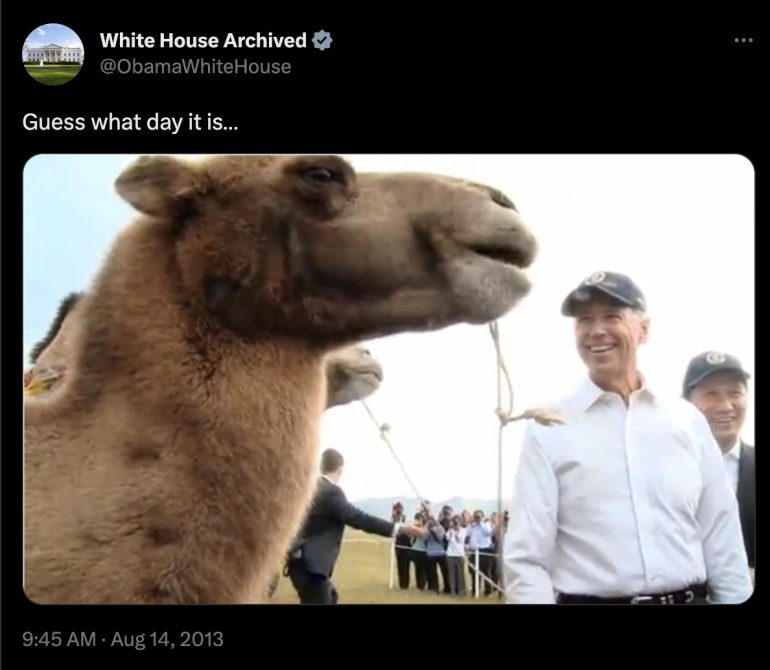
What You Can Learn From This Example
- Find a unique and humorous angle. Sometimes, add a twist. GEICO has always made animals famous through its ads. The company spends about $1 billion a year on advertising. What made this ad different was the inclusion of “Wednesday” in the mix, which caused the engagement to skyrocket.
- Keep it simple – don’t overcomplicate the message. Like GEICO, go straight to the point after your ad intro and pitch your product to avoid losing your audience. For GEICO, the message is, “How happy are folks who save hundreds of dollars switching to GEICO? Happier than a Camel on Wednesday.” Using a recurring theme like GEICO’s camel, also signals to consumers what brand the ad is for almost immediately.
12. Spotify: Make It Personal
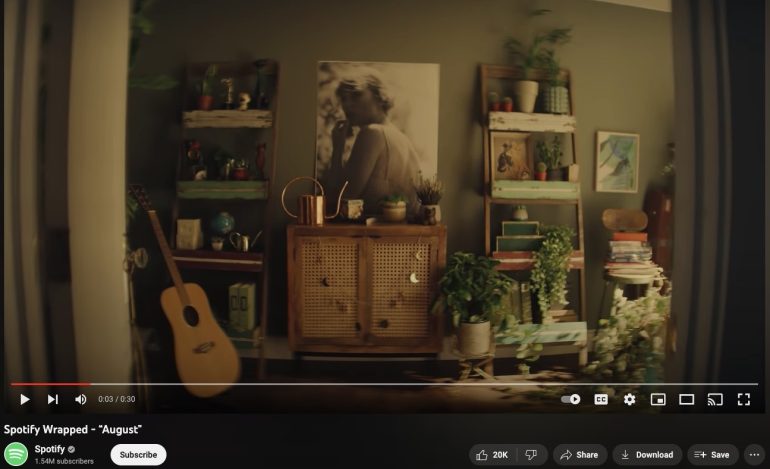
Why It’s A Good Example
- It’s a multichannel campaign that transcends from online to offline. With this campaign, users got a personalized review of their listening habits. The campaign also honored podcasters and musicians who kept people entertained and informed during the grinding COVID-19 crisis of 2020.
- Mobile app downloads of Spotify’s app increased by 21% after this campaign. How did they do it? Influencer marketing. Besides allowing users to check the artist, time, and the number of songs played, Spotify created an Artist Wrapped. This allowed popular musicians and podcasters to thank their Spotify listeners on social media, causing more brand awareness for the audio streaming platform.
What You Can Learn From This Example
- Think out of the box if you want people to share your product. Without incentivizing users or paying influencers, Spotify successfully got users to share their results from its product. While listeners did this because they felt good about it, musicians and podcasters shared their Artist Wrapped as it could get them more followers. This is a simple situation of “What’s In It For Me.” The right answers to this question can drive your product towards social media virality.
- Make it easy for your customers to increase your brand awareness. If you have a product like Spotify, you’ll want to build in-app features so your audience can share their story in one click. This allowed Spotify to reduce their audience’s effort in posting their Wrapped stories on social media.
13. Old Navy: Let Your Audience Inspire You
Old Navy Written by the Internet
Why It’s A Good Example
- Old Navy’s “Written by the Internet” gave fans exclusive access to the brand. They did this by taking to social media and requesting fans’ input about what they wanted to see in an ad. Sparking excitement, the post generated 1,500 comments, allowing the Old Navy team to turn their virtual audience into co-creators.
- By tapping into the creativity of its audience, Old Navy took an excellent stride to forge a stronger bond with its customers. They even hired the TikToker who inspired this ad. Collaboration that produces outcomes like this will further endear the brand to its youthful audience.
What You Can Learn From This Example
- Try something that’s never been done. This ad was the first of its kind where a virtual audience of commenters inspired a commercial. Irrespective of your audience size, you can use this strategy to generate insights from your social media followers and your email list subscribers.
- Listen to customers. By relying on user-generated content, Old Navy showed they are a responsive brand willing to give customers what they want. The CMO of Old Navy even mentioned that they’d get more marketing ideas from fans for their future campaigns. The outcome? More brand awareness and a loyal customer base.
14. Sephora: Foster A Sense Of Belonging
We Belong to Something Beautiful
Why It’s A Good Example
- An inclusive campaign reflects the world we live in. By creating a campaign that recognizes this, Sephora uses this campaign to connect with its audience on a deeper and more meaningful level.
- After taking viewers through 90 seconds of the ad, the video wraps up with a call-to-action, inviting the viewer to check out Sephora’s commitment to the transgender and non-binary community on its website. This is a brilliant way to end the ad as it prompts users to learn more about Sephora and what they support.
What You Can Learn From This Example
- Connect your marketing to your company’s core values. One of Sephora’s core values is diversity and inclusion. Sephora positions themselves as an entity that walks the talk by creating commercials that align with its values. Your customers should see you in a similar light.
- Humanize your brand by speaking up. Many brands prefer to shy away from controversial topics. Not Sephora. While companies often ignore having discourse about gender and other social issues, Sephora took a stand on this subject. Pick a side as well, especially on topics in your industry.
15. Starbucks: User-Generated Content
Why It’s A Good Example
- It portrays the importance of face-to-face connections in a world where relationships are now mostly remote. Without in-person interactions, there’s less laughter, less cheering, no hugs, no handshake, and no fun dances. All these dilute what community means to us, and Starbucks uses this ad to remind us of the joy that comes with FaceTime.
- The campaign isn’t stereotypical. It shows people from over 28 countries who meet at Starbucks for multiple reasons. This makes the campaign personalized to every viewer, irrespective of who they are or their Starbucks location.
What You Can Learn From This Example
- Create stories your viewers can relate to. People connect and engage with stories because humans are narrative creatures. Starbucks knew customers usually use their coffee shops for dates, lunches with strangers, and meetups with friends. Knowing this, they replicated the exact story that brought a typical customer to a Starbucks coffee shop.
- Personalize your ad experiences. Like Starbucks, your ads shouldn’t alienate any segment of your audience. If you have thousands of stores in 80 countries, it’s best to represent each country in your ad. This way, customers will know you prioritize everyone who uses your product.
16. Patagonia: Purpose-Driven Marketing
Why It’s A Good Example
- Patagonia pulls on a cause its target audience cares about: protecting the planet. This video, part of a three-episode mini-series, appeals to the 82% of consumers who want a brand’s values to align with their own.
- It uses storytelling. To make the brand’s cause more engaging to consumers, Patagonia tells the story of how its ultra-runner customer, Majell Backhausen, ran 273 km. This type of storytelling provokes emotion, making it instantly more memorable.
- The product isn’t the focal point. Patagonia lands itself in the marketing hall of fame because its advertisement doesn’t come across as too salesy—an off-putting element for many consumers. Instead, the brand’s values are front and center of its marketing campaign.
What You Can Learn From This Example
- Supporting a cause goes a long way. Find a mission, purpose, or value that your customers share. Make this the focal point of your marketing campaign to stand out from brands that just want to sell products.
- Experiment with long-form video. Thanks to the rise of TikTok and Instagram Reels, we live in a world of short, snappy content. Use Patagonia’s marketing example as inspiration to experiment with longer content formats. A mini-series of films can be much more engaging than a 15-second video.
- Invite your customers to tell their stories. Instead of piling the pressure on your marketing team to produce engaging stories, put the onus on your customers. They’d likely jump at the chance to have their stories heard—especially if it’s a big achievement.
17. Duolingo: Witty TikTok Campaigns
Why It’s A Good Example
- It’s an effective campaign shot on mobile. Modern cell phones come equipped with incredible cameras and video recording functionality. Duolingo’s TikTok content uses nothing more.
- The comments section continues the laughs. Duolingo engages millennials and Gen Z, both tech-savvy generations, through the comments section. For example, someone commented, “The new Kardashian.” Duolingo responded with, “It’s giving North.”
- Studies have shown that 90% of people are more likely to remember funny campaigns and almost three-quarters would choose a funny brand over the competition. Duolingo’s TikTok campaigns deliver these consumer experiences.
What You Can Learn From This Example
- Brand mascots aren’t outdated! What might seem like a concept only used by sports teams in modern times, Duolingo’s cheeky owl shows that mascots can add personality to a brand.
- Memes can be done tastefully. Instead of using photos of other people (which, when used without permission, can land your business in hot water), Duolingo uses the meme format to create its own laughable content.
- Comments on your campaign are another opportunity to further your reach and campaign effectiveness. Engage with the people who interact with your social media marketing campaigns — even if it’s a short, snappy one-liner.
18. Dove: Real Beauty Campaign
Why It’s A Good Example
- The best marketing examples are centered around a pain point the brand’s target audience feels. Dove’s campaign does exactly that. It eases anxiety around our biggest insecurity — what we look like — to make people feel good. Those positive emotions become attached to the Dove brand.
- It involves an industry expert. Social proof is a powerful type of content that proves your marketing isn’t biased. Dove achieves this by inviting Gil Zamora, an FBI-trained forensic artist, to sketch the images. These drawings are instantly more credible than if they were drawn by a marketer who works for Dove.
- The campaign has a key strapline: “You’re more beautiful than you think.” This one-sentence affirmation leaves viewers with some positivity.
What You Can Learn From This Example
- Distill a common myth or misconception your customers have about themselves. Dove breaks down the idea that people aren’t as unattractive as they think. Find this inner belief for your target market and boost their confidence through your campaign.
- A feel-good strapline can solidify your brand image in the mind of an ideal customer. Create a positive affirmation related to your campaign and consider using this as the campaign’s title, closing statement, and call to action.
- Add credibility to your marketing message with a third-party expert endorsement. Like Dove’s FBI-trained artist, find someone with no commercial relationship to your brand. Involve them in your campaign to make the content feel unbiased.
19. Google’s Year in Search: Data-Driven Marketing
Why It’s A Good Example
- It has a distinct campaign title and hashtag. Google encourages viewers of its video (and corresponding article) to share the data across social media using the hashtag #YearinSearch — furthering the reach of its marketing campaign.
- Despite Google’s target audience being anyone with internet access, it personalizes its marketing efforts by sharing the questions most frequently searched for in its search engine. People who want to be more spontaneous, change careers, or become a fighter pilot see themselves in the video.
- It rounds up the biggest internet trends of the year. From the child who sang about corn on TikTok (aka “the corn kid”) to Beyonce’s latest album, Google’s Year in Data campaign amalgamates the best trends of each year. This provides a sense of nostalgia and community amongst people who lived through them.
What You Can Learn From This Example
- Numbers don’t have to be boring. Whether it’s internal sales data or a big survey you’ve run, lean into the numbers and use them to tell stories. (You likely have more of this data available than you think.)
- Tell the stories of multiple customers. Keep things short and snappy, like Google’s campaign video, by profiling an assortment of customers — rather than just one.
- Even the biggest brands don’t necessarily put thousands into world-class video production. This example largely consists of existing footage merged with Google data, so don’t put off your next marketing campaign for fear of not having enough budget to produce a compelling ad.
20. Twitter: Nostalgia and Success Campaign
Why It’s A Good Example
- It uses celebrity tweets without necessarily asking the celebrity to do any extra work. Twitter simply resurfaced old tweets from successful stars like Megan The Stallion, Niall Horan, and Demi Lovato to show how their younger selves tweeted the dreams they later went on to achieve.
- The celebrities shown were highlighted in their hometown. These local communities likely recognized their home-grown star more than those outside the county and, therefore, likely paid more attention to the marketing campaign.
- Production costs were minimal. Often, the best marketing examples are simple. This one from Twitter was just a small collection of screenshots paired with photos taken of celebrities achieving the things they tweeted about.
What You Can Learn From This Example
- Distill the hype around your brand influencers or celebrity partners. Prove to your audience that they’re real people, just like themselves, so they can vision themselves using your product and having the same effect.
- Influencer marketing doesn’t have to be expensive. Find natural occurrences of celebrities using or talking about your product. Ask for permission to use those snippets in your marketing campaigns and leverage their celebrity status without the hefty collaboration price tag.
- Going granular with your campaign targeting can engage more people. In Twitter’s case, it highlighted celebrities from eight different cities, pairing the celebrity with their hometown.
21. John Lewis: Anticipated Christmas Celebration
Why It’s A Good Example
- It has an unexpected twist. The video shows a man learning how to skateboard just before Christmas. Towards the latter end of the campaign, we learn why: the family is fostering a child in the care system who loves to skateboard.
- It subtly highlights a single product. Despite John Lewis being one of the largest department stores in the UK, it doesn’t boast about its impressive catalog in this marketing example. Instead, one product — a skateboard — is incorporated into the story.
- John Lewis profiles its charity partners in the campaign. This added touch shines a light on unrepresented nonprofits, who often struggle with low marketing budgets but do incredible work.
What You Can Learn From This Example
- Build anticipation around your marketing campaigns. The John Lewis Christmas campaign is a hot topic at the end of each year. Deliver one big, surprising, emotional campaign for your business and build hype around it each year.
- Not all stories have to be complex. This one shows a man learning to skateboard in preparation for a new child.
- Sometimes, music is more effective at telling stories than words. The John Lewis campaign has very few words in the first half. Instead, it relies on music to support the visuals and tell a story of determination.
Now that you have all the examples you need to help you stand out, try some of them to improve your marketing and grow your brand.

